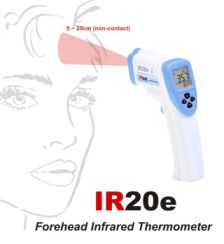|
Forehead Infrared Thermometer IR20e |
 |
|
Written by Administrator
|
|
Monday, 23 November 2009 02:01 |
Introduction
Body temperature is measured by pointing the Infrared thermometer IR 20e at the centre of the forehead. The correct distance is between 5 – 20 cm. There is no need to align the distance to read the correct temperature. Therefore it is easier and faster to use IR 20e as long as it stays within the specified range. Pull the trigger and within a split of a second, a beep is heard and the result is displayed and hold (frozen) for a few seconds before it turns off by itself. |  |
- Is the red LED light illuminating from the IR thermometer harmful?
The red LED is to help illuminating the forehead (target). Led light is natural light and therefore harmless. Do not be alarmed. Led light is not a laser light. - How does the IR20e work?
The IR20e collects infrared energy emitted by body heat. Forehead is a perfect spot to take temperature; the heat is supplied by the temporal artery where blood flows from the aorta and the carotid. - Why has to be forehead?
As explained on question no 2, forehead is a perfect spot and the head has a higher thermal sensitivity comparing to the other part of the body, it changes temperature at a faster rate. - What is a healthy temperature?
To successfully use the IR 20e thermometer with confidence, it is imperative to understand that there is no fix healthy temperature. Every body has his own healthy temperature zone (HTZ).
HTZ is varied according to age :
| Age | Range | | Celcius | Farenheit | | 0 to 2 years | 36.4°C ~ 38°C | 97.5°F ~ 100.4°F | | 3 to 10 years | 36.1°C ~ 37.8°C | 97.0°F ~ 100.4°F | | 11 to 65 years | 35.9°C ~ 37.6°C | 96.6°F ~ 99.7°F | | > 65 years | 35.8°C ~ 37.5°C | 96.4°F ~ 99.5°F |
Generally speaking, the HTZ is from 35. °C ~ 38.0°C (96.4°F ~ 100.4°F).
Fever is 38.0°C (100.4°F). - Does temperature taken from the forehead reflects the highest body temperature?
Yes, but it is not a true temperature, it is a corrected temperature against the oral temperature (temperature taken from inside of our mouth). It is the software correction inside the chip. The actual forehead temperature is almost always lower than the temperature taken from other covered part of the body such as oral, rectal/rectum, axillary/armpit, tympanic/eardrum). This is mainly due to heat dissipation, the lower the air temperature surrounding, the faster the heat dissipation takes place and vice versa. IRTEK applies automatic correction on the internal software to offset the reading to reflect the highest temperature of the body. - Can we use the IR 20e below 20°C or above 35°C (outdoor)?
Yes but it will not be within the accuracy specified in the manual. You need to establish a new HTZ threshold based on your experience.
The ideal situation is to use between 20°C ~ 35°C and indoor. - Why choose IR20e thermometer instead of ear thermometer?
In the last few years, ear thermometer has gained popularity over the conventional thermometer as it is faster to take temperature but ear thermometer suffers from its own setbacks:
-
Positioning the ear probe to target (era drum) can be tricky because ear drum is not always perpendicular to ear opening, resulting in correct reading and poor repeatability. -
Ear wax in the ear canal can be an obstruction to the infra red path. IR will read lower than the actual. Not to say left and right ear is not the same. It needs several readings to confirm. -
If there is an infection inside the ear, the reading will be incorrect. -
Patient with moist ear in the ear canal may also be incorrect. -
There is a running cost to replace the protective cover each time a measurement is taken. In hospital, it can be quite costly. -
Slower than the Forehead thermometer as mentioned previously and can be problematic to scan a fast moving crowd such as school, public venue at time of pandemic/epidemic. -
Operator has to have a closer contact with the target and this close contact operation can be apprehensive or uncomfortable to operator who is not well trained in their job.
Despite the setbacks, ear thermometer has been widely accepted as a standard practise either at home or hospitals and clinics as a rapid test until the new age forehead thermometer are born. - Why does the thermometer read below 34°C or error in some cases?
Measuring forehead with perspiration will have a lower temperature or forehead with excessive wrinkles (elderly) will tend to read lower. Instead of forehead, measure the temperature behind the ear around the neck. It will give you moderately correct temperature. - How to successfully implement the forehead thermometer in hospital or clinic environment?
A sound knowledge of how the infra red forehead thermometer IR 20e works and the definition of healthy temperature zone are mandatory. Otherwise it will undermine the outcome of the measurement and the confidence of the user. - What are the general quick guide and useful tips?
- Use the IR thermometer only at room temperature or indoor (20 to 35°C) and relative humidity under 90%.
- Maintain distance from 5 to 20 cm to forehead when taking temperature.
- Make sure no perspiration on the forehead.
- Take 2 or 3 measurements for the best results. Pick the highest value.
- Make sure no hair is obstructing the IR path.
Disclaimer
The reading of IR 20e is not the actual reading of the forehead temperature but is a corrected reading derived from the internal software, therefore will not produce the same result when aiming at the black body calibrator.
|
|
Last Updated on Tuesday, 22 December 2009 12:16 |

